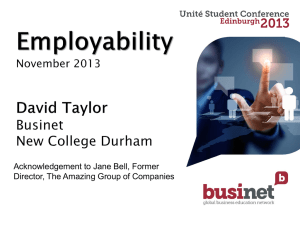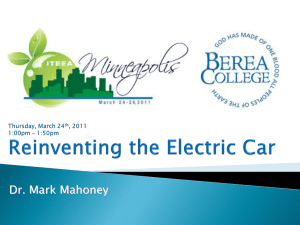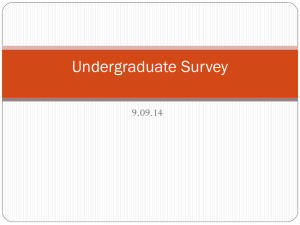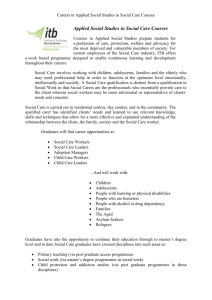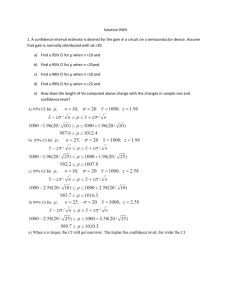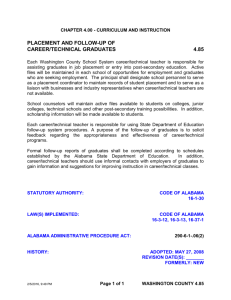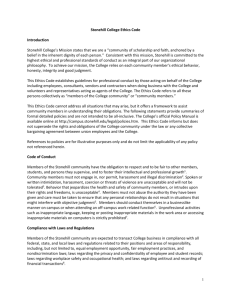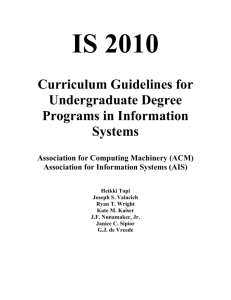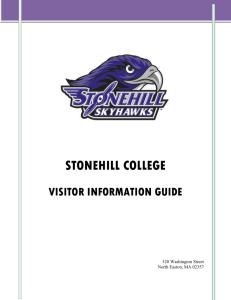ArsDigita University – An Intensive Post
advertisement
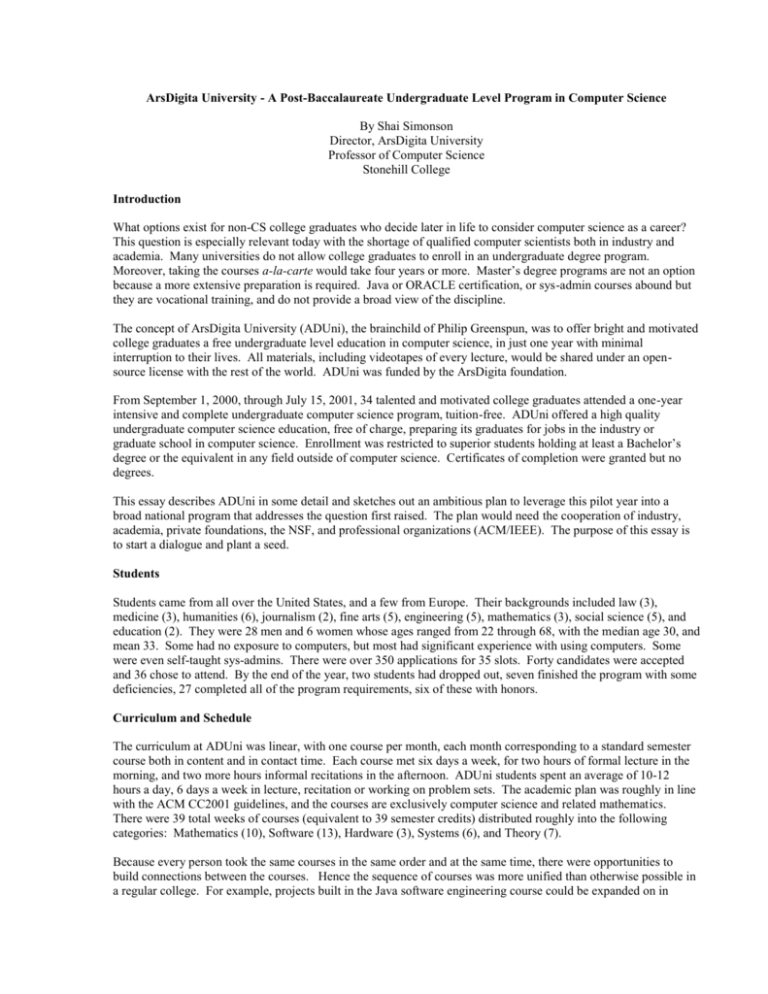
ArsDigita University - A Post-Baccalaureate Undergraduate Level Program in Computer Science By Shai Simonson Director, ArsDigita University Professor of Computer Science Stonehill College Introduction What options exist for non-CS college graduates who decide later in life to consider computer science as a career? This question is especially relevant today with the shortage of qualified computer scientists both in industry and academia. Many universities do not allow college graduates to enroll in an undergraduate degree program. Moreover, taking the courses a-la-carte would take four years or more. Master’s degree programs are not an option because a more extensive preparation is required. Java or ORACLE certification, or sys-admin courses abound but they are vocational training, and do not provide a broad view of the discipline. The concept of ArsDigita University (ADUni), the brainchild of Philip Greenspun, was to offer bright and motivated college graduates a free undergraduate level education in computer science, in just one year with minimal interruption to their lives. All materials, including videotapes of every lecture, would be shared under an opensource license with the rest of the world. ADUni was funded by the ArsDigita foundation. From September 1, 2000, through July 15, 2001, 34 talented and motivated college graduates attended a one-year intensive and complete undergraduate computer science program, tuition-free. ADUni offered a high quality undergraduate computer science education, free of charge, preparing its graduates for jobs in the industry or graduate school in computer science. Enrollment was restricted to superior students holding at least a Bachelor’s degree or the equivalent in any field outside of computer science. Certificates of completion were granted but no degrees. This essay describes ADUni in some detail and sketches out an ambitious plan to leverage this pilot year into a broad national program that addresses the question first raised. The plan would need the cooperation of industry, academia, private foundations, the NSF, and professional organizations (ACM/IEEE). The purpose of this essay is to start a dialogue and plant a seed. Students Students came from all over the United States, and a few from Europe. Their backgrounds included law (3), medicine (3), humanities (6), journalism (2), fine arts (5), engineering (5), mathematics (3), social science (5), and education (2). They were 28 men and 6 women whose ages ranged from 22 through 68, with the median age 30, and mean 33. Some had no exposure to computers, but most had significant experience with using computers. Some were even self-taught sys-admins. There were over 350 applications for 35 slots. Forty candidates were accepted and 36 chose to attend. By the end of the year, two students had dropped out, seven finished the program with some deficiencies, 27 completed all of the program requirements, six of these with honors. Curriculum and Schedule The curriculum at ADUni was linear, with one course per month, each month corresponding to a standard semester course both in content and in contact time. Each course met six days a week, for two hours of formal lecture in the morning, and two more hours informal recitations in the afternoon. ADUni students spent an average of 10-12 hours a day, 6 days a week in lecture, recitation or working on problem sets. The academic plan was roughly in line with the ACM CC2001 guidelines, and the courses are exclusively computer science and related mathematics. There were 39 total weeks of courses (equivalent to 39 semester credits) distributed roughly into the following categories: Mathematics (10), Software (13), Hardware (3), Systems (6), and Theory (7). Because every person took the same courses in the same order and at the same time, there were opportunities to build connections between the courses. Hence the sequence of courses was more unified than otherwise possible in a regular college. For example, projects built in the Java software engineering course could be expanded on in Algorithms. Database projects could consist of optimizing previously designed web sites. Discussion of recurrence equations in discrete math could build on experience with recursion in Scheme. List of Courses A list of courses with brief descriptions is shown below. For more detail regarding texts, requirements, content, and faculty, please see our web site, http://aduni.org. The number of weeks (and hence semester equivalent credits) per course is marked in parentheses. Month 0 - Mathematics for Computer Science (4) A basic introduction to the Calculus and Linear Algebra. Teaches mathematical literacy for science and engineering. Month 1 - Structure and Interpretation of Computer Programs (4) An introduction to programming and the power of abstraction, using text of the same name. Month 2 - Discrete Mathematics and Probability (4) Emphasis is placed on providing a context for the applications of the mathematics within computer science. Month 3 - How Computers Work (3) The basics of digital logical design, computer organization and architecture including assembly language, processor design, memory hierarchies and pipelining. The distinction between RISC and CISC architectures is emphasized. Month 4 - Object-oriented Program Design and Software Engineering (4) The concepts of the Object-oriented paradigm using Java, and the basic principles of software engineering are emphasized. Event-driven programs with GUIs are designed. The large group project is to develop a server/client for Gnutella, a distributed music-sharing system similar to Napster without the central server. Month 5 - Algorithms (4) The design and analysis of algorithms, and how to handle NP-Complete problems. Emphasis is placed on the trade-off between experimental and theoretical results. Month 6 - Systems (3) Case studies of working systems provide comparisons and contrasts. This course’s group project is to write an NSF systems proposal to fund a middle-ware product, for announcement RFP01-63. Month 7 - Software Engineering for Web Applications (4) The basics of designing a dynamic web site with a database back end. Scripting languages, cookies, SQL, and HTML. Computer-human interface and the graphical display of information are emphasized. This course is built around a month long project. Crucial to the project is the identification of a client with whom the group must work designing specifications, implementing them, evaluating, and testing. Month 8 - Theory of Computation (3) A theoretical treatment of what can be computed and how fast. Applications to compilers, string searching, and control circuit design are discussed. Month 8 - Artificial Intelligence (1) An overview of AI from the technical and the philosophical points of view. Taught by Patrick Winston. Month 9 - Unix Workshop (1) A self-study workshop to review and/or learn a wide range of Unix tools. This course was pass/fail. Month 9 - Database Management Systems (3) Database systems are studied from the physical layer of B-trees and file servers, to the abstract layers of relational design. Month 10 - Applied Probability (2) This course extends the discrete probability learned in month 2, and focuses on applications rather than proofs. A problem set based on identifying tumors using MRI (Magnetic Resonance Imaging) was done using Matlab. Colloquia A nice feature of ADUni was its monthly colloquium. Every month we invited a prominent speaker from industry, academia, or other parts of the greater computer science community to speak to our students. Our location and mission allowed us to recruit some superb speakers, (including Gerry Sussman, Richard Stallman, and Mike Sipser). A standard university CS department would never have the time, interest or resources to consistently round up such a fine set of speakers for an undergraduate audience. The colloquia were videotaped and are available for free on our web site. Physical Space The physical space at ADUni was crucial to its success. It created an environment in which the social and academic center of the students’ (and staff’s) lives was in the lab, rather than the dorm, pub, or library as it might be in a more traditional school. This not only encouraged collaboration, but also allowed for more flexible pedagogy. The contrast with a typical college where classmates see other twice a week for 90 minutes and perhaps at an arranged study-date, was significant. For example, at ADUni we never gave an exam in the lecture hall. Each student simply worked at his or her own workstation in the lab. On-line access was available during lab and exams, without any special arrangements. The distinctions between exam, assignment, problem set and project, sometimes got blurry. Ad-hoc group review sessions were easily organized by the teaching staff and by students for themselves. The lab was a large open room with forty stations. Each station was equipped with a 3’ by 6’ table, a small file cabinet, and a Linux workstation with Internet access. Each student had his own textbooks and space. There were a few tables up in front of the room reserved for teaching assistants, and there were bookshelves holding a small library. In the center of the room, was a movie theatre style popcorn machine, a water cooler and a portable white board. The lab was the nerve center of ADUni. It was filled with students from 9-9, and was rarely empty at any time of the day or night. For many students it was their home for the year, and they left only to sleep. Faculty and Staff ADUni had one full-time faculty member and three full-time teaching assistants (TAs). Many part-time faculty and teaching assistants were hired from MIT and nearby high tech companies. Each course had one lead faculty member in charge of lectures, lecture notes, problem sets and overall course design. The TAs, in addition to serving as a resource for students, assisted with grading, tutorials, problem set design, recitation sections, and website maintenance administration. There was a full-time administrator who was assisted by two volunteers to handle the day-to-day logistics, including guest speakers, admissions, publicity, web postings, payroll, events, and evaluations. All lectures and many recitations were taped, most by a professional videographer, the rest by student and staff volunteers. Evaluation ADUni was a huge success. The students learned. They completed a rigorous curriculum (readings, exams, problem sets and projects), and performed better overall, according to their professors, than the typical undergraduate class. The graduation was an emotional event, as many of the 34 graduates prepared to start new careers. Within the next five years, I estimate 2-5 students will enroll in Ph.D programs, 20-25 will be software engineers, 4-6 will apply the knowledge to their established careers, and 2-3 will move on to new careers related indirectly to computer science. All lectures and recitations were videotaped and are available free to the public under an open source license at http://aduni.org. The problem sets, solutions, exams, and lecture notes are also available, as are student evaluations and suggestions for every course. Many people have made use of our videos and other materials provided on-line. Our site gets bandwidth traffic of 12G per day and plenty of good feedback. The ADUni concept had some advantages over the standard undergraduate model. 1. 2. 3. 4. The set of classes were designed as a symphony rather than independent pieces. The environment encouraged the students to work more seriously and focus harder. There was a natural collaboration among the students. Work was intense and focused on one topic at a time, a style that worked better than I expected. Future Plans – ADUni as Pilot Study ADUni can be used as a pilot study for an ambitious but exciting model of education in computer science. This new model would address the need for more qualified technical people in the workforce as well as the shortage of graduate students in computer science. It would efficiently tap into the reservoir of talented graduates that dream of computer science as a career option, but are faced with either vocational programs, or multi-year academic commitments. An Independent National Post-Baccalaureate School of Computer Science An independent national program can leverage our first year’s start-up effort and experience. The program, based on the ADUni pilot tested curriculum, would not grant a degree but would be accredited by ACM or CSAB/ABET. Colleges and universities would sponsor satellite sites, and provide lab space and fulltime mentors. The continuity and community would be provided by these local sites and mentors. Instructors would be experts in academia or industry brought in on a per course basis. The web can be used for weaving connectivity between sites. A conference once a year, would allow all sites to meet and share results. It would, however, not be a distance-learning program. What distance learner can simulate the ADUni lab? What distance learner dedicates 12 hours a day? The national program should strive to mimic the success of ADUni, which was an on-site phenomenon, hence the need for local mentors. The educational details have been designed and tested. The pilot year’s graduating class will provide the reputation. The idea needs manpower, money, organization, and support from the computer science community. The costs can be covered by tuition, and joint sponsorship of the NSF, private foundations, and academic institutions. This educational effort can bridge the communication gap between academics and industry. It can open computer science up to the largest untapped market in the world – bright professionals with a new career dream. For Further Information A more detailed description of the program, links to all our course materials, and the current status of our graduates can be found at http://aduni.org. Acknowledgments Thanks to David Goddeau , Tara Holm, John Pezaris, Ellen Spertus, Lynn Stein, Gerry Sussman, and Patrick Winston for helpful discussions. Shai Simonson, Professor and Director of ADUni (http://aduni.org) Department of Computer Science Stonehill College, North Easton, MA 02357 Voice: (508) 565-1008 Fax: (508) 565-1444 Email: shai@stonehill.edu Home Page: http://www.stonehill.edu/compsci/shai.htm


